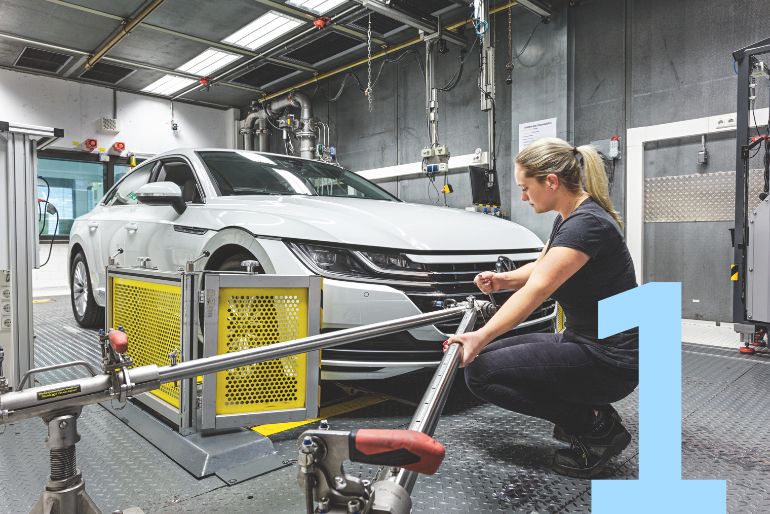On the dynamometer and the streets – how we test our new models

1
An Arteon is tested on a roller dynamometer in Wolfsburg. The test vehicle is rolled in and secured before the start of the new, 30-minute WLTP driving cycle. Currently the test is in full swing in Hall 79 in Technical Development – in three shifts on 21 dynamometers, almost around the clock.

2
The WLTP test is underway. Test driver Celine Liers follows the precise, legally required driving cycle with phases of acceleration, deceleration and stopping. The average speed along the 23-kilometer course is 47 km/h. During measurement, any special and additional equipment that has been installed is taken into account for each model. The range of engine-transmission model for the Golf, for example, is extremely broad. For the next generation, this wide variety means a particularly heavy test workload.

4
Change of location: in the RDE test center in Fallersleben, there are ten test stations for mobile exhaust measurements, which are coupled to the WLTP test. This measurement process is called “RDE” (“Real Driving Emission”). During RDE, the cars are tested for 90 to 120 minutes on the road. The route consists of inner city roads, country roads and highways. Around 20 employees perform these emissions tests. Adrian Barth (front) and Björn Buttgereit calibrate the measuring devices using test gas cylinders. This is necessary before and after every test on the road.

5
The Arteon carries a yellow box containing the mobile measuring system on its tail end during the RDE on-road test. It measures the emissions of CO₂, carbon monoxide (CO), nitrogen oxide (NOx) and particles (particulate matter) in real driving conditions. The 50-kilogram device is connected to the exhaust using a special stainless steel connector, to guarantee there are no leaks in the test setup.
![]()
WLTP – Questions and Answers
The new test procedure poses big challenges for Volkswagen – inside presents the most important facts at a glance.
What exactly is the WLTP?
Legislators are implementing standardized test procedures for the type approval of new vehicles. These procedures measure the exhaust emissions, fuel consumption and CO₂ emissions, as well as the range for electric vehicles. In the European Union, these tests were previously based on the New European Driving Cycle (NEDC). However, this will now be replaced by the WLTP. The abbreviation WLTP stands for “Worldwide Harmonized Light Duty Vehicles Test Procedure.” The aim of the WLTP is to determine more realistic CO₂ emissions and fuel consumption values for customers.
When will the WLTP take effect?
All newly launched models and engines have already had to be tested to WLTP standards since September 1, 2017. From September 1, 2018, this will also apply to all newly registered vehicles, even existing models. From September, the registration on new vehicles without WLTP testing will no longer be permitted. For light commercial vehicles, the transition period is one year later.
How is the new test procedure different from the old one?
The new test cycle is considerably longer and more substantial. It includes frequent braking and accelerating, and the average speed is higher. Special equipment is also taken into account if it affects the weight, aerodynamics or roll resistance.
What are the challenges for the Volkswagen Group?
New values need to be measured for a total of 260 engine-transmission models. Then there are the many different special equipment options that need to be taken into account. For the Golf alone, there are two million possible combinations. The challenge: time is extremely limited. From the date that the new law took effect, there was only 13 months’ time to prepare for the WLTP.
Will the company manage to implement the WLTP in time?
Probably not for all models. But all the departments involved have been working under high pressure for months to try and keep the impact as low as possible. There are external factors at play, too, such as the capacities of the licensing authorities, which play a very important role.
Will certain models be temporarily unavailable?
Yes, some engine-transmission models will be unavailable for a while. For now it’s all about keeping the downtime and the number of affected models as low as possible. By the way, other automotive manufacturers are facing the same challenge. But almost nobody has as many model and engine types as the Volkswagen Group.
Will production be affected, too?
That cannot be ruled out. However, the company is doing all it can to prevent any impact on production or at least keep it as low as possible. To achieve this, all the departments are working closely together to ensure, for example, that the Volkswagen brand can fine-tune its mode of operation in the plant as accurately as possible.
What are the consequences of the WLTP for employees?
In production, there may be temporary fluctuations as we transition to the WLTP. The departments are working closely together on this. If there are any changes to the operating procedures, employees will be informed as soon as possible. Due to the WLTP, we are currently proceeding cautiously according to circumstances.
A few tips:
Save weight, so keep as little cargo on board as possible.
Plan your routes well to avoid unnecessary detours.
Drive slower, for example, 130 km/h rather than 160 km/h on the highway.
Use the cruise control system, if available.
Let the vehicle coast to a stop rather than braking (drive predictively) and accelerate gently.
